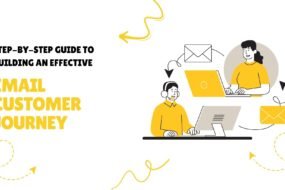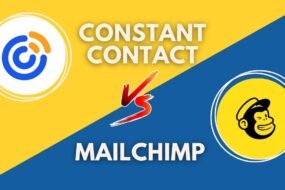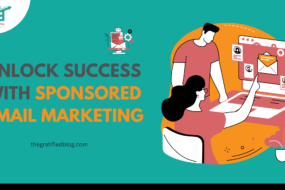
So, how to write a newsletter? If you have recently set foot in the world of email marketing, then a newsletter sounds intimidating to you. If you are still trying to get it right in your first draft, this article will tell you exactly how to write a newsletter!
What Is A Newsletter?
If you have an e-commerce website and want to reach your target audience regularly, a newsletter helps you connect with them frequently.
A newsletter is a tool that does the communication right and touches the pain points of your target audience by delivering the information to them via email. These emails might be plain text or have a structure made up of graphics and styled text, such as a newsletter format.
In practice, we all receive multiple emails daily, and newsletters are a great medium to stay in touch with the brands we follow. A well-structured newsletter can provide valuable information, updates, and engaging content to keep subscribers informed and entertained.
When crafting a newsletter, it’s essential to consider its structure to ensure clarity and readability. Starting with a compelling introduction, followed by sections or headings that organize the content, can help guide readers through the newsletter seamlessly.
Additionally, incorporating visually appealing elements like images, infographics, and typography can enhance the overall design and make the newsletter more visually appealing.
By carefully considering the newsletter structure, brands can create a compelling communication tool that captures subscribers’ attention and effectively conveys their message.
What Is The Need For A Newsletter?
Newsletters are frequently used by those who own websites, blogs, or e-commerce to sell a product, content, or article, announce an event, or engage in remarketing efforts, such as the abandoned cart — not to mention the standard transactional communication.
The fundamental objective of a newsletter is to:
- Stay connected with the audience.
- Give direction to the success of the blog or website.
- Increase traffic
- Share a variety of content with the audience.
- Attract visitors with intriguing content.
Why Is A Newsletter Such An Effective Marketing Tool?
Digital marketing is incomplete without email marketing, mostly newsletters. It channelizes communication with the target audience by giving it a personal touch. The best way is to inform the audience rather than piling up their inbox with repeated and useless emails.
However, as important as that is the low cost of each shipping. If you own an e-commerce site, you know how much this may affect your sales, profit margins, and the potential that brings you into the relationship with your customers.
So, is it worthwhile to spend on email marketing and newsletter distribution? Yes, of course! Nevertheless, is it simple to send newsletters? No, not at all.
Furthermore, many firms have realized that email marketing and newsletter distribution work, but they need help figuring out how to get started, leaving an essential tool on the table.
Sending a newsletter necessitates multidisciplinary expertise because the person who sends the newsletter must create the newsletter’s design, prepare the message to be shipped, identify objectives, and know how to analyze the results of this distribution.
Good newsletter examples showcase the seamless integration of captivating design, compelling content, and measurable outcomes. It is crucial to study successful newsletters to understand the art of engaging readers and achieving desired goals.
By examining the strategies employed in these exemplary newsletters, one can gain valuable insights into crafting impactful communications that resonate with the target audience.
How To write A newsletter That Engages The Audience?
Do you have an idea about how to write a newsletter? Then, it comes to writing an engaging one. When bridging the gap between the audience and your services, newsletters are the best way to educate your audience and connect with them and their needs.
If you are new to writing newsletters, these stepwise guidelines will help you pull the strings and guide you on how to write a newsletter fluently.
Choose Your Purpose
Isn’t the purpose of a newsletter to keep people up to speed on your company?
Yes, in general, and you can do it for the following reasons:
- To keep people informed about the articles published on your site.
- To highlight key industry events and explain how they relate to your business.
- To notify customers about continual improvements to your products or services.
- To share information about your most recent client projects and availability.
As you may have guessed, the purpose of your newsletter will dictate the structure and content of your emails. If you want to share recent blog entries, your emails should include photographs, blurbs, and links to the pieces for your featured post.
For instance, People Matters Online does weekly roundups to engage its audience:
They share news, insights, and views about the current scenarios, tagging along with the other topics on their website.
Then, there are educational newsletters.
Many companies also produce instructional newsletters. These newsletters are designed to teach their readers new skills to help them attain their goals. This is an excellent method to establish expertise while providing tremendous value to your subscribers.
These newsletters are frequently formatted simply, with an emphasis on the content.
For example, Scripted helps writers with straightforward, crisp, knowledgeable content:
It will also carry a link to the complete article, which indirectly serves more than one purpose:
- It encourages people to engage on the website.
- It gives them the freedom to share the content.
- It indeed allows the team Scripted to control the length of the email.
You may use a different formula but remember that even in an informative email, you should always provide subscribers with another method to interact with your website.
Frequency Of The Email
One thing that you don’t want is to get a notification of someone unsubscribing to your newsletters. So, what could you do to sustain your audience? The first thing to do is to decide how often you would share the newsletters. The things you can put under consideration are:
- Time investment in the newsletter: The ingredients of your newsletter must contain both quality and a proper schedule. Once you start writing newsletters, you have to be consistent in making time to write at least one newsletter every week. You must follow the pattern to keep yourself on the right track.
- Exciting updates: Once you learn how to write a newsletter successfully and provide updates on the projects, you can share exciting updates related to your long-term projects.
Sales emails: People prefer their inboxes to be filled with something other than sales emails. If you are writing sales emails, occasional emails regarding product releases, offers, and discounts won’t hurt anyone. Like the newsletters by Nykaa Fashion:
This is regular enough for individuals to remember your company without being so frequent that it becomes overwhelming. Later, you may consistently increase the frequency or create separate newsletters with different frequencies.
Schedule Days To Draft And Send The Newsletter
Now that you have a newsletter template ready, it’s time to plan when you’ll publish and distribute this content. This entails assigning a definite date and time to each procedure stage. For example, your newsletter schedule could look like this:
Draft: Every month on the 11th at 1 PM.
Send it every month on the 16th at 10 AM.
It gives you a surety that you always schedule your newsletter ahead of time rather than rushing to finish it at the last minute.
Pro tip: Make your drafting day a recurring event in your preferred calendar app and set up a phone notification. You will be held liable as a result of this.
Template Design
One of the best aspects of a newsletter is that you can build a single template and use it for all your newsletters. This helps you to establish a consistent, branded design while saving a significant amount of time.
The simplest method is to find a template online and edit it to your specifications. There are dozens of high-quality, responsive newsletter templates available for various industries. Canva, Envato, and MailPoet are all options.
Once you are done selecting the template for either of the websites, then you can customize them accordingly. The main changes that you can make are:
- Place your logo
- A specific newsletter banner
- Give sections to your email template
Once you feel satisfied with your creations, you can download the document. A download option is available on the upper right of the Canva settings. The downloaded document will be saved on your computer.
How To Start With Your First Newsletter?
When you have assorted everything for your newsletter, it’s time to breathe life into it. So, you can follow the things mentioned below to hit enter with success:
Keep It Short And Crisp
Embarking on your inaugural newsletter might seem intimidating, but it doesn’t need to be a daunting task. The key is to keep it concise and to the point, starting with a captivating line that instantly captures your audience’s attention. Shorter messages are easier to comprehend, and a compelling opening line sets the stage for sustained engagement with the rest of the content.
Consider employing various techniques to make your opening line truly intriguing. You might pose a thought-provoking question, weave an exciting narrative, or kick off with a surprising statistic. Tailor your approach to resonate specifically with your audience, and don’t shy away from challenging their beliefs—this adds an extra layer of interest and ensures that your newsletter remains compelling throughout.
Remember, the goal is to draw readers in from the very beginning and keep them hooked as they delve into the content you’ve curated for them.
Give It A Personal Touch
Infusing a personal touch into the commencement of your inaugural newsletter holds the potential for a profound impact on your audience. An effective way to achieve this connection is by addressing subscribers with their first names, a subtle yet powerful gesture that fosters a sense of intimacy with your brand. To implement this, ensure that your signup forms collect this information, enabling you to seamlessly incorporate names using shortcodes in your emails.
The simplicity of including a subscriber’s first name can go a long way in nurturing a stronger relationship with your audience. This personalized approach demonstrates that you view your subscribers as individuals rather than mere recipients of information. This foundational element not only sets a tone of genuine care but also establishes the groundwork for a successful and enduring newsletter.
As you tailor your communication to each subscriber, you not only increase engagement but also convey the message that their presence is valued and significant in the content you deliver.
Short Paragraphs
The length of your paragraphs holds significant weight in maintaining reader engagement within your newsletter. Lengthy paragraphs have the potential to discourage readers, leading to a loss of interest. To counteract this, it’s crucial to opt for concise and focused paragraphs that swiftly get to the heart of your message. This approach not only facilitates better comprehension but also ensures that your audience remains captivated throughout.
By keeping your paragraphs brief and to the point, you create a more accessible and digestible reading experience for your subscribers. Each paragraph should encapsulate a clear idea or thought, allowing readers to effortlessly follow the flow of information.
This strategy not only enhances the overall readability of your newsletter but also caters to the modern reader’s preference for concise and impactful content. In essence, the art of crafting short paragraphs contributes significantly to the creation of an engaging and easily consumable newsletter that resonates with your audience.
Stick To The Purpose
Navigating through the influx of approximately 100 daily emails that individuals receive poses a considerable challenge, emphasizing the importance of brevity and clarity in your communication. It’s advisable to keep your emails succinct and focused, adhering to the principle that precision enhances impact. However, exceptions may arise when disseminating exclusive or information-rich updates through your newsletter, where a slightly extended format might be justified.
Embarking on your inaugural newsletter requires careful consideration of your audience, content strategy, frequency, and format. Begin by crafting a welcome email that not only sets the tone for your communication style but also establishes clear expectations for what subscribers can anticipate.
In this initial email, prioritize conciseness and directness while incorporating a personal touch by sharing a glimpse of yourself. The use of subscribers’ first names further contributes to forging an emotional connection, enhancing the overall impact of your welcome message.
The Selling Point
In constructing a compelling newsletter, center your focus on elements that resonate profoundly with your audience, steering clear of inundating them with intricate day-to-day updates about your company. Opt instead for a spotlight on exceptional experiences, notable achievements, and substantial advancements directly affecting your customers. Pinpoint the selling points that are poised to capture their attention and sustain their engagement.
Crafting the content of your newsletter requires a strategic approach, emphasizing value and relevance. Provide insights and solutions that align with the needs and interests of your audience, maintaining a conversational and personalized tone to foster a sense of connection.
Enhance the visual appeal and accessibility of your newsletter by incorporating compelling visuals and concise descriptions. Lastly, actively encourage feedback and interaction to establish a dynamic, two-way communication channel with your subscribers, ensuring that your newsletter becomes a platform for meaningful engagement.
Call To Action
Any statement, phrase, or image that urges subscribers to interact with your brand is a call to action. For example, encourage people to read an article, comment on your most recent update, or even share your newsletter with their friends.
Utilizing data analytics will enhance the caliber of the newsletter
If you want success in your newsletter journey, keep data analytics handy. You can do this by paying close attention to the details like:
- The subject line should be capable of grabbing the most attention.
- Do some research to find out the best time to send emails to get more reads.
- Choose an effective call-to-action type.
- Choose the most clicked links.
- Keep checking who is reading the newsletters; it will give you an idea to segment the information list.
Conclusion
The most common error newsletter writers make is including articles that should be shorter. The most extended article should not take up more than two columns on a three-column page; most pieces should be fewer than 100 words.
You may learn how to reduce information into small pieces by studying newspaper business briefs. You must provide headlines, a phrase or two describing the story’s subject in e-newsletters, and a link to the entire piece. Remember to have someone else proofread the newsletter before you send it out.








No Comments